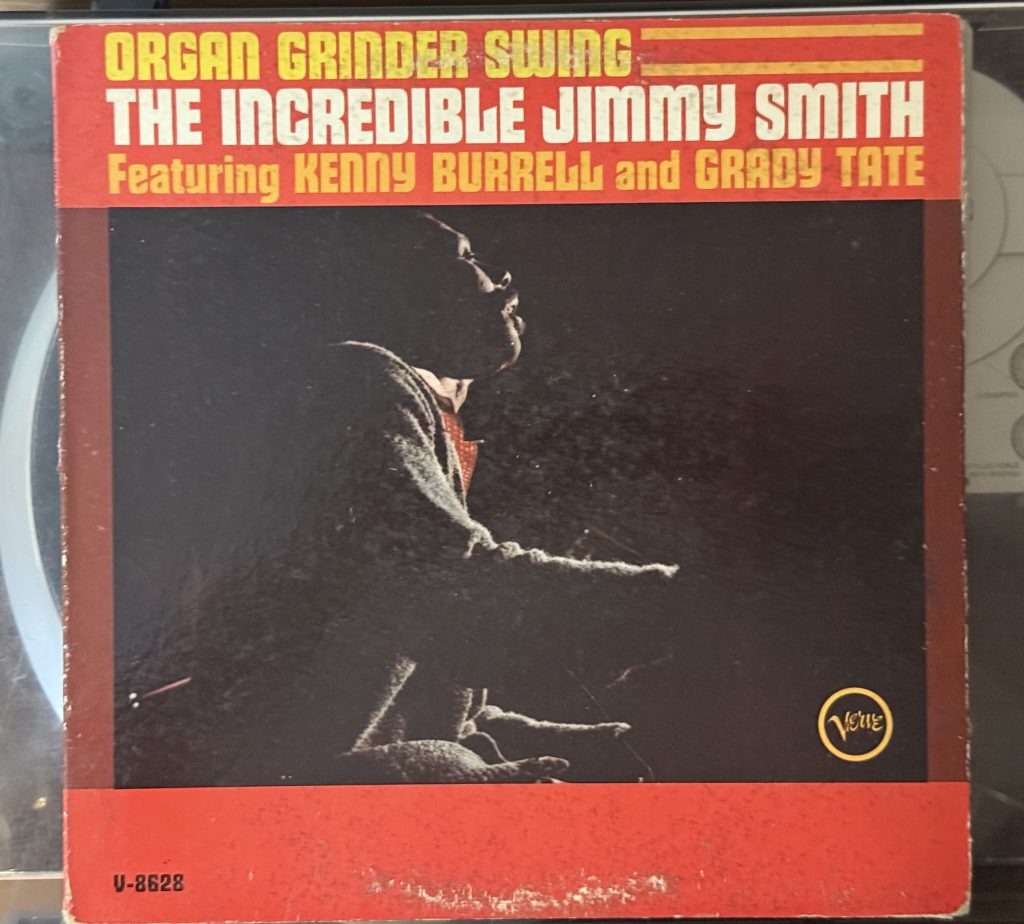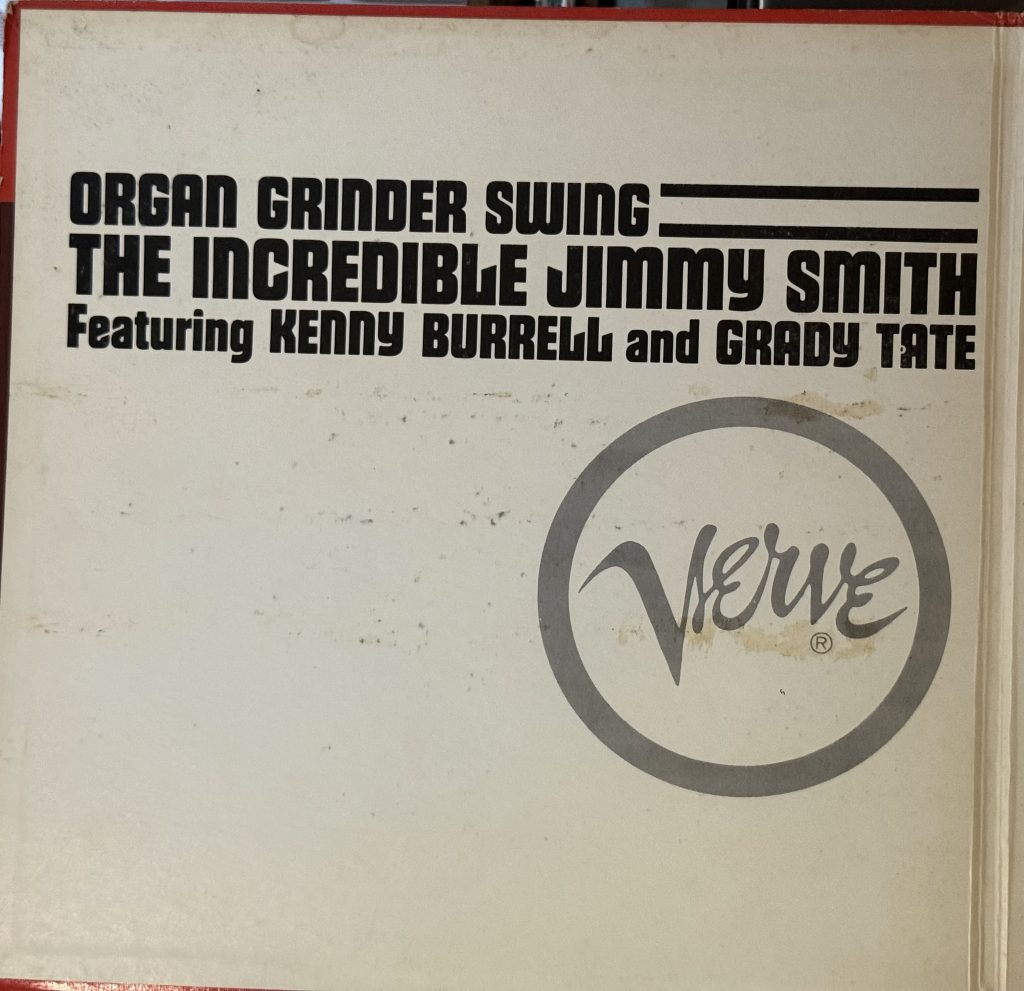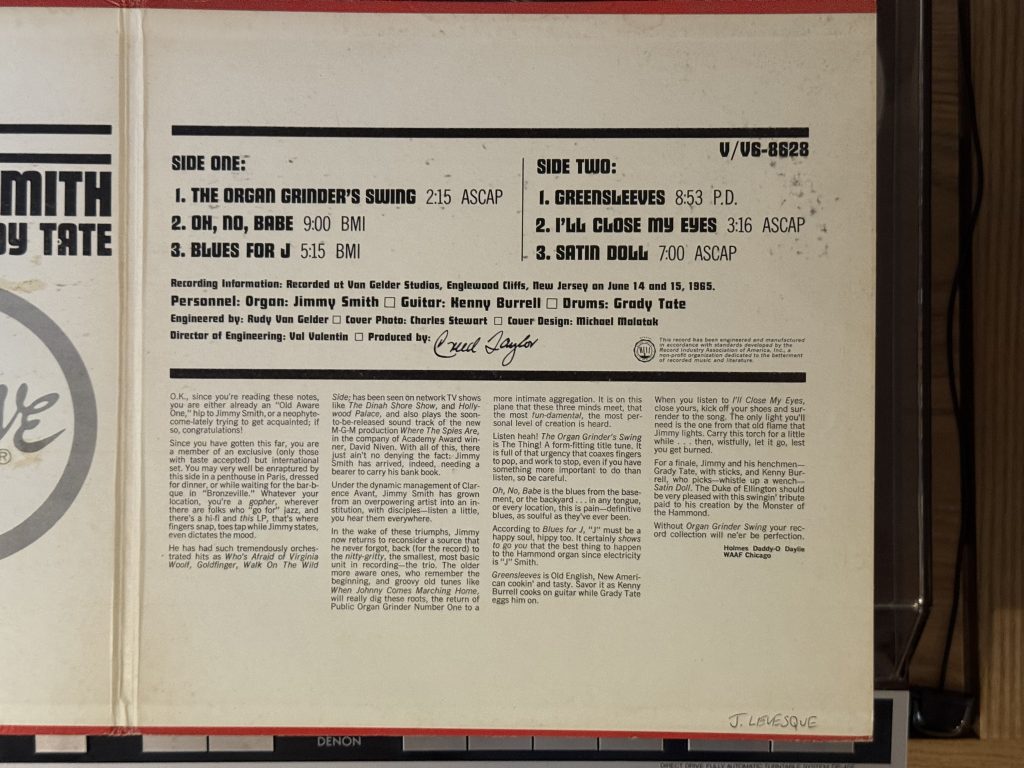
Album of the Week, August 23, 2025
After his first set of albums for Verve, including massive orchestral arrangements courtesy of Oliver Nelson and Claus Ogerman, as well as ’60s pop freakouts courtesy of the amazing Lalo Schifrin, it must have seemed like Jimmy Smith could do anything. What he did, in fact, was quietly subversive: he went back to basics.
Recorded in June 1965, Organ Grinder Swing marked a return to the organ trio format, allowing us to hear Smith’s craft in a more intimate setting. Both Kenny Burrell and Grady Tate return from the 1964 recordings, so there’s a feeling of simpatico among the three players. They produced a set that was both more relaxed and more ambitious than the 1964 recordings, one that made a big impact on the jazz organ repertoire.

“Organ Grinder’s Swing” seems to start mid-thought, with a snare hit and a bluesy organ riff that is already going full tilt over choogling guitar chords. Then: an organ hit, and what can only be described as a mumble. I’m pretty good at deciphering studio chatter, and I’ve replayed that mumble so many times that my 15 year old has started to give me side eye, and I still can’t figure out what Jimmy says. Someone online claims he was speaking the lyrics to the Organ Grinder’s song. Sure. We’ll go with that. What the mumble signifies is that we’re playing loose and relaxed, and that’s a good thing. Jimmy then plays the main melody, which bears a striking resemblance to “I Love Coffee, I Love Tea.” (Looking at you, songwriter Will Hudson.) Kenny Burrell rips a swinging solo and passes it over to Smith, who makes with some serious boogying. Then: more mumbling, one more run through the blues, a hit, and it’s over. The tune, released as a single, broke the Hot 100, topping out at 92; in a just world, it would have gotten higher.
More studio chatter starts off “Oh No, Babe,” as Jimmy calls out the take number, someone in the background yelps, and he hits a bluesy chord, then sings “Oh no, babe” before hitting a series of dark chords. He hollers a little, grunts a little, and eventually finds his way into a blues, with Kenny Burrell limning out the chords as Smith finds them. We get a melodic solo from Kenny that takes us deeper into the deeply funky waters, with Smith approvingly moaning “Oh yeah” behind him. There’s a simmering tremolo from Smith that stretches over eight long bars before erupting into a boil. He continues to build tension this way for three more verses before taking a step back and trading licks with Burrell, up to a triumphant final fanfare. For a studio jam, it’s also a masterclass in Smith’s improvisational style.
“Blues for J” is another Jimmy Smith blues, but this one is more tightly composed, with some offbeat chords setting up a merry romp down the keys. Here Smith does a little grunting but a lot more dazzling keyboard work, taking it romping down the street with a happy little blues dance. It says something about this record that even a tossed off composition like this one feels tightly composed and arranged; Smith was having fun but he was also on fire.

That brings us to “Greensleeves,” and you’re well warned to buckle your seatbelt for this one. There had been other jazz arrangements of “Greensleeves” before, but Smith’s clear point of departure is John Coltrane’s 1961 adaptation from his great Africa/Brass, complete with the alternating suspended chords, here played by Smith himself as the introduction to the tune. Again we jump right into the swing of things, with Burrell sketching out the chords while Tate propels things from beneath. Jimmy plays the chorus a beat behind throughout, leading to some happily disorienting rhythmic fakeouts when the alternating chords return. Burrell sounds as though he had been waiting all week for someone to ask him to solo over modal chords, and he takes two runs before Jimmy steps in. Jimmy’s energy is infectious—no noodling around the blues here, he’s cranked up to 11 from the very beginning. At the same time, some of the improvisational gestures are familiar; he still leans on the chords across multiple bars to build tension, and from his work with the orchestras he’s learned the art of leaning into the higher octave to signal the climax. At the five-and-a-half minute mark, he reprises the theme, making us think we might be drawing to a close, but he explodes out of the recap with another swirling soul arpeggio, a tossed-off chromatic descending scale, and more. Ultimately Creed Taylor and Rudy Van Gelder have to fade out the jam; it shows every sign of continuing indefinitely into the present.
The Billy Reid/Buddy Kaye classic “I’ll Close My Eyes” here begins as a muted ballad, with Kenny Burrell taking the lead over Smith’s gentle chordal accompaniment and Grady Tate’s brushes. Smith’s solo continues in the same contemplative vein, though the organ’s timbre ensures a less wistful mood. Then it’s straight into Duke Ellington’s “Satin Doll,” which at first sounds like a straight read, until you hear the chord progression out of the A part of the chorus into Kenny Burrell’s B part. There’s a lot more going on in this arrangement, from Burrell’s slightly off-kilter, always virtuosic reading of the melody through his solo, through Smith’s increasingly crunchy chords and doggedly bluesy take on the melody. When he rolls his way through a verse, and takes another in a high tone that sounds like nothing so much like a skating rink solo, you just have to sit back, nod your head, and listen. To paraphrase another great artist, the funk is so fat you might gain weight … but that’s a different record for another time.

Though the standout here is clearly “Greensleeves”—other organists have taken his arrangement and made it a standard part of the Hammond repertoire—this whole album stands as a landmark of the jazz organ canon. At once relaxed and ambitious, and always deeply soulful, it’ll make a believer out of even the most skeptical listener.
Smith continued to record at a high rate for Verve through the end of the 1960s and into the early 1970s. There were a few other sessions released on other labels as well; next week’s represented an archival find when it was originally released in 1966.
You can listen to this week’s album here:
BONUS: Here’s Jimmy and the band playing the title cut live in 1965 from the Hollywood Palace:
